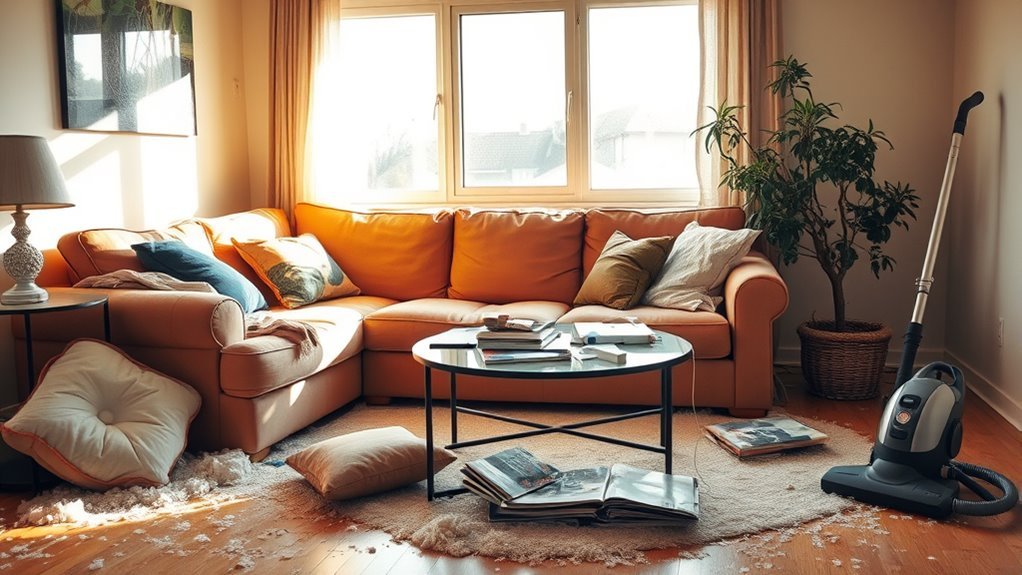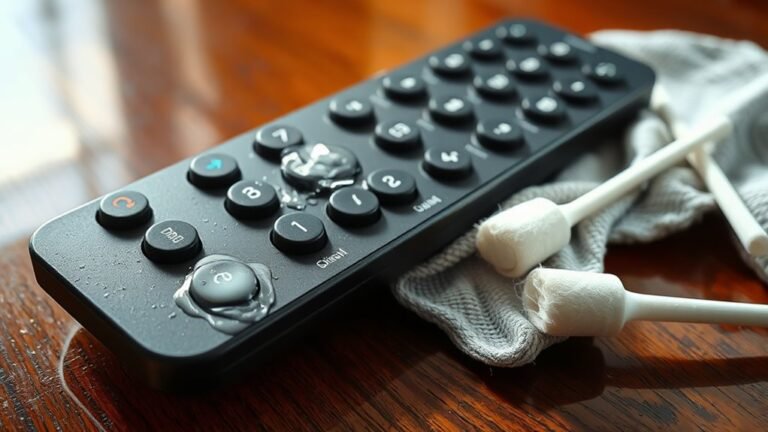Common Mistakes When Cleaning Living Room
You might be using harsh chemicals on delicate surfaces, damaging wood or fabrics without knowing it. Ignoring baseboards, corners, and under furniture leaves dust and grime behind. Overlooking upholstery care and failing to dust electronics properly can also reduce cleanliness and comfort. Plus, using dirty cleaning tools spreads germs instead of removing them. Skipping regular vacuuming and spot cleaning lets dirt build up. If you want to improve your living room’s freshness and hygiene, keep exploring these common pitfalls.
Using Harsh Chemicals on Delicate Surfaces
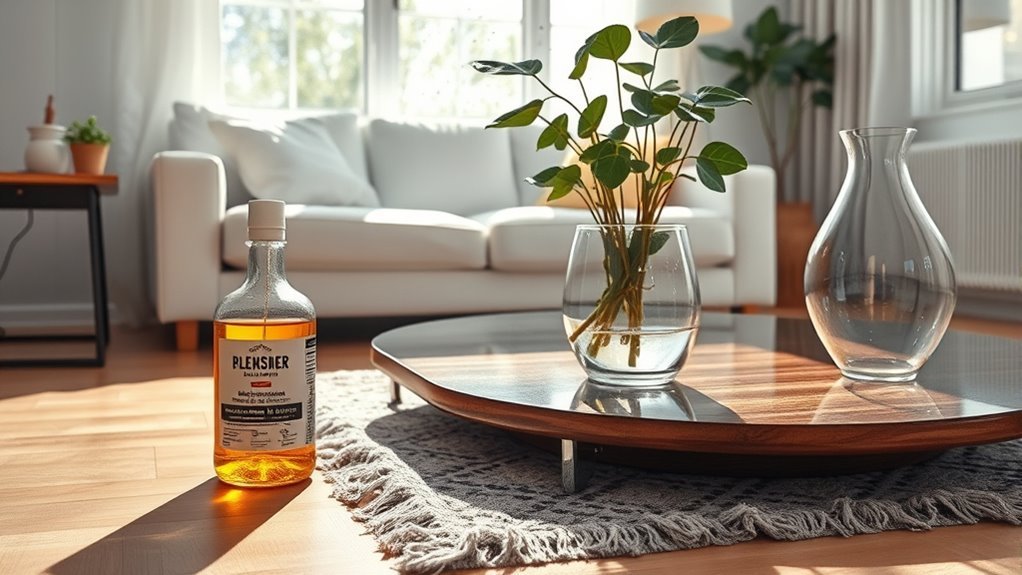
Although it might seem like a quick fix, using harsh chemicals on delicate surfaces can cause lasting damage. When you clean your living room, you want freedom from worry—not to fret over ruined finishes or faded colors. Delicate materials like wood, silk, or leather deserve gentle care. Instead of reaching for strong cleaners, consider chemical alternatives that protect these surfaces while still doing the job. Simple solutions like diluted vinegar, mild soap, or specialized gentle sprays can keep your space fresh without compromising its beauty. By choosing safer options, you maintain both the look and feel of your living room, giving you peace of mind and the freedom to enjoy your space without hesitation or regret.
Ignoring the Baseboards and Corners
Even if you clean the main surfaces thoroughly, neglecting baseboards and corners can leave your living room feeling unfinished. These areas often collect dust and grime unnoticed, making your space look less fresh. Skipping baseboard cleaning means missing out on a simple way to boost your room’s overall cleanliness and vibe. Make corner dusting a regular habit—it’s where dust loves to settle and hide. Grab a microfiber cloth or a soft brush to reach these tight spots easily. By giving attention to these overlooked areas, you free your living room from hidden dirt and create a more inviting environment. Don’t let baseboards and corners become the weak link in your cleaning routine; tackle them and enjoy a truly clean, liberating space.
Overlooking Upholstery and Fabric Care
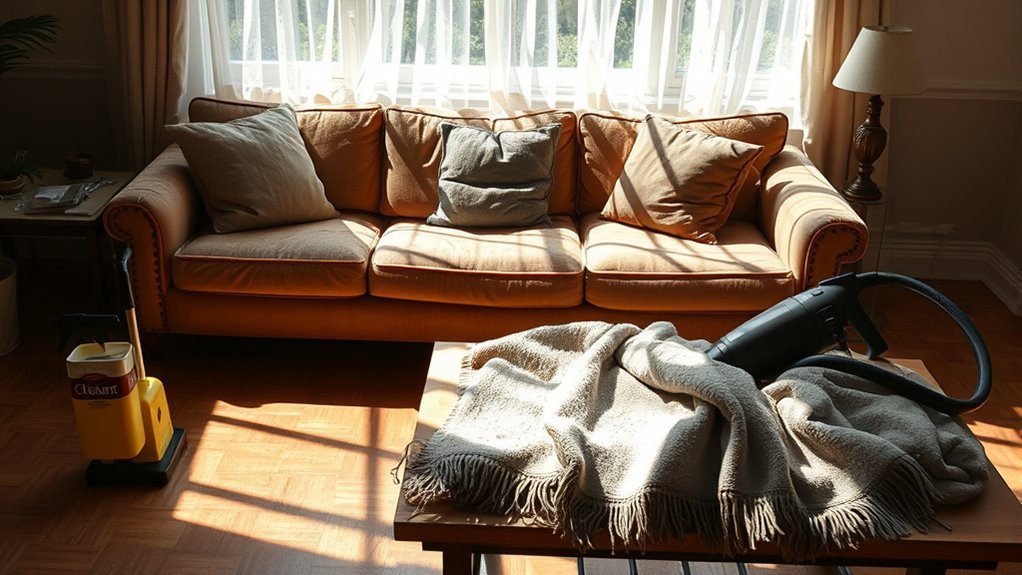
Once you’ve tackled dust and dirt in the baseboards and corners, it’s easy to forget that your living room’s upholstery and fabrics need care too. Skipping upholstery maintenance can shorten the life of your furniture and leave fabrics looking dull or stained. To keep your space inviting and free, make fabric protection a priority. Regular vacuuming removes dust and crumbs, preventing buildup that attracts pests or causes wear. Spot clean spills promptly, using appropriate cleaners to avoid damage. Consider applying fabric protectors to repel stains and spills, giving you peace of mind and more freedom to enjoy your living room without constant worry. By paying attention to these details, you’ll preserve both the look and comfort of your furniture, ensuring your living room stays fresh and welcoming.
Failing to Dust Electronics Properly
When you clean your electronics, using harsh cleaning agents can cause serious damage. You also need to be careful not to ignore screen sensitivity, as it requires gentle handling. Don’t forget to dust ventilation slots, since blocking them can lead to overheating.
Using Harsh Cleaning Agents
A common mistake people make while cleaning their living room is using harsh cleaning agents on their electronics. You might think stronger chemicals clean better, but they can actually damage delicate surfaces and ruin your devices. Instead, choose eco friendly alternatives that are gentle yet effective. These options respect surface compatibility, ensuring your electronics stay safe without harmful residues. Avoid sprays with ammonia or alcohol, which strip protective coatings and cause discoloration. A microfiber cloth slightly dampened with water or a mild solution is often enough to remove dust and smudges. By picking the right cleaners, you protect your gadgets and the environment, giving you the freedom to maintain a clean, healthy living space without unnecessary risks.
Ignoring Screen Sensitivity
How often do you consider the sensitivity of your screens while dusting your electronics? Ignoring screen sensitivity can easily damage your gadgets. Using rough cloths or harsh sprays can harm the screen protection and reduce touch sensitivity, limiting your freedom to use devices smoothly. You want your electronics clean, but also safe.
Here’s a quick guide to protect your screens effectively:
| Cleaning Tool | Screen Type |
|---|---|
| Microfiber cloth | Smartphones, Tablets |
| Compressed air | Keyboards, Speakers |
| Screen-safe spray | TVs, Monitors |
| Soft brush | Laptops, Consoles |
| Dry cloth | E-readers, Smartwatches |
Keep these in mind to maintain screen protection and preserve touch sensitivity without limiting your device’s usability.
Overlooking Ventilation Slots
Since dust buildup in ventilation slots can cause your electronics to overheat, you’ve got to make certain you clean these areas regularly. The ventilation importance in your living room goes beyond just keeping devices cool; it directly affects the air quality you breathe. When dust clogs these slots, not only do your gadgets struggle to perform, but dust particles circulate in the air, limiting your freedom to enjoy a clean, healthy space. Don’t overlook these tiny openings—they’re easy to miss but critical for proper airflow. Grab a soft brush or compressed air to gently clear dust without damaging components. By maintaining clean ventilation slots, you protect your electronics and make sure the air in your living room stays fresh and free from unnecessary dust buildup.
Neglecting to Clean Under Furniture
One of the most overlooked areas in your living room is right beneath the furniture. When you focus solely on visible surfaces, you miss out on the hidden dust accumulating under sofas, chairs, and tables. Your furniture placement can unintentionally trap dirt and allergens in these neglected spots, affecting air quality and your comfort. To truly free your space from grime, make it a habit to move pieces periodically and clean underneath. This simple step prevents buildup that regular vacuuming or dusting won’t reach. Don’t let hidden dust limit your living room’s cleanliness and your peace of mind. Taking control of these concealed areas guarantees a fresher, healthier environment where you can fully relax and enjoy your home.
Using Dirty Cleaning Tools
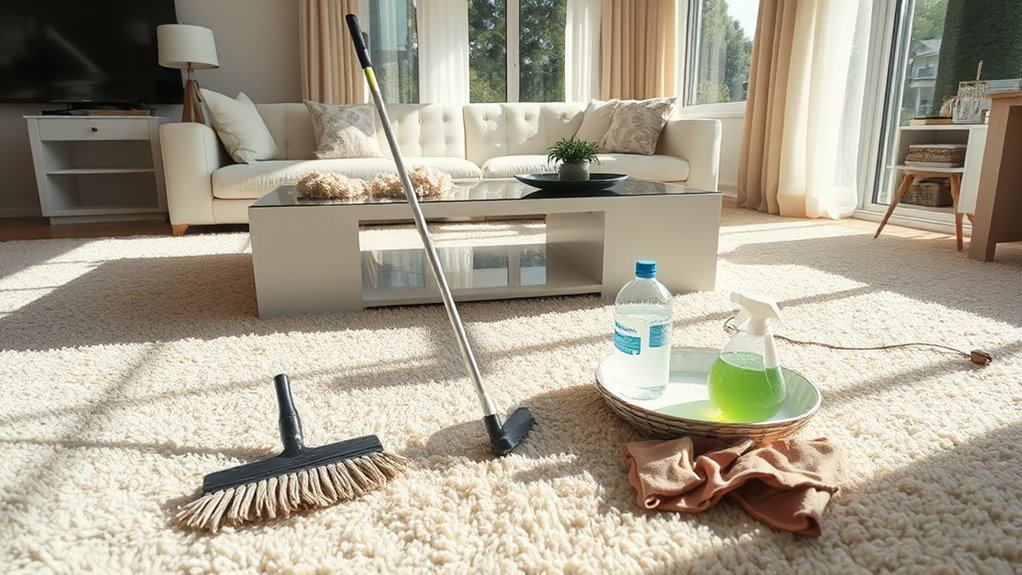
If you use dirty cleaning tools, you’re just spreading germs around instead of getting rid of them. This not only makes your cleaning less effective but also increases the risk of cross-contamination. Keeping your tools clean is key to a truly fresh living room.
Germs Spread Rapidly
Although you might think your cleaning tools are helping, using dirty ones can actually spread germs faster throughout your living room. When you reuse grimy cloths or mops without proper washing, those tools become carriers of bacteria and viruses, turning germ hotspots like remote controls, doorknobs, and cushions into contamination hubs. To keep your space truly clean and safe, it’s essential to maintain a strict cleaning frequency for your tools. Wiping surfaces with fresh cloths and sanitizing your cleaning gear regularly breaks the cycle of germ transmission. Don’t let dirty tools undermine your efforts—embrace a routine that respects both cleanliness and your freedom to enjoy a healthy living room without invisible threats lurking around. Keep those tools clean, and germs won’t stand a chance.
Ineffective Cleaning Results
Keeping your cleaning tools fresh not only stops germs from spreading but also guarantees your efforts actually make a difference. Using dirty tools leads to ineffective techniques, leaving dirt behind and wasting your time. To avoid this, focus on these essentials:
- Clean your sponges, cloths, and brushes regularly to maintain their effectiveness.
- Replace tools that show wear or can’t be sanitized properly.
- Adjust your cleaning frequency based on how quickly your living room collects dust and dirt.
- Store tools in a dry, clean place to prevent bacteria growth.
Cross-Contamination Risks
When you use dirty cleaning tools, you risk spreading germs instead of eliminating them. This undermines your efforts and compromises the health of your living space. To maintain freedom from unwanted bacteria, focus on cleaning tool hygiene. Regularly washing or replacing sponges, cloths, and mop heads is essential for effective cross contamination prevention. Using the same dirty cloth on multiple surfaces transfers dirt and germs, defeating your purpose. By keeping your cleaning tools fresh, you guarantee each wipe genuinely cleans. Embrace a routine that prioritizes tool cleanliness to safeguard your home and enjoy a truly clean living room. Remember, freedom from contaminants starts with the tools you trust to do the job right.
Skipping Regular Vacuuming and Spot Cleaning
A common mistake you might make is skipping regular vacuuming and spot cleaning in your living room. Maintaining the right vacuum frequency and mastering spot cleaning techniques keeps your space fresh and inviting. Here’s how to stay on top of it:
Skipping regular vacuuming and spot cleaning can quickly make your living room look tired and uninviting.
- Vacuum high-traffic areas at least twice a week to prevent dust buildup.
- Use spot cleaning techniques immediately on spills to avoid stains setting.
- Don’t forget to vacuum under furniture and cushions to catch hidden dirt.
- Schedule a deep vacuum session monthly to refresh carpets and rugs.
Frequently Asked Questions
How Often Should I Deep Clean My Living Room Carpets?
You should deep clean your living room carpets every 12 to 18 months to keep them fresh and vibrant. Proper carpet maintenance not only extends their life but also improves your home’s air quality. Of course, cleaning frequency depends on your lifestyle—if you have pets or kids, you might want to clean more often. Stick to a schedule that fits your freedom-loving lifestyle while keeping your space welcoming and cozy.
What Is the Best Way to Organize Living Room Clutter?
Organizing living room clutter can feel like trying to tame a wild jungle! You’ll want to embrace decluttering strategies that focus on what truly sparks joy and toss what doesn’t. Use clever storage solutions like baskets, shelves, or multi-functional furniture to keep things out of sight but within reach. This way, you’ll create a space that frees your mind and lets you breathe easy, turning chaos into calm with minimal effort.
Can Plants Improve Air Quality in the Living Room?
Yes, indoor plants can definitely boost air quality in your living room. They naturally filter toxins and release oxygen, making the space fresher and healthier. Plus, having greenery around gives you a sense of freedom and calm. Choosing the right plants—like snake plants or pothos—can enhance air purification without much effort. So, if you want cleaner air and a relaxed vibe, adding plants is a simple, natural solution you’ll appreciate.
How Do I Remove Pet Hair Effectively From Furniture?
Imagine your friend Sarah, who struggles with pet hair on her couch. She swears by using a rubber glove as a cleaning tool—just dampen it and run your hand over the furniture. The hair clings easily, making cleanup quick and freeing her from endless vacuuming. You can try this too, or use specialized pet hair brushes or lint rollers. These tools help you reclaim your space without hassle or limits.
What Are Eco-Friendly Cleaning Alternatives for the Living Room?
You can easily switch to eco-friendly cleaning alternatives in your living room by using natural cleaners like vinegar, baking soda, and lemon juice. These DIY solutions are not only safe but also super effective for dust and stains. Just mix them with water for a gentle yet powerful cleaner. Embracing these options gives you the freedom to maintain a fresh, toxin-free space without relying on harsh chemicals.
